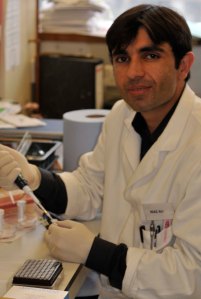
Dr Niaz Ali, Hazara University, Mansehra, Pakistan works on the introgression of characters from alien species into wheat, having completed his PhD in Leicester in 2012 with Dr Trude Schwarzacher. He presented his PhD work at the Annual Meeting of the Society for Experimental Biology (SEB http://www.sebiology.org/meetings /Valencia/Programmes.html) in the session on Exploiting genetic diversity for cereal breeding, and was awarded the runner up prize in the plant section Young Scientist Awards.

Molecular cytogenetic and epigenetic characterization of the alien chromatin specifying resistance to Wheat streak mosaic virus (WSMV)
Niaz Ali (Hazara University Mansehra [HUM], Pakistan), Habib Ahmad (HUM, Pakistan), Robert Graybosch (University of Nebraska, USA), Pat Heslop-Harrison (University of Leicester, UK) and Trude Schwarzacher (University of Leicester, UK)
Decades of selection for greater yield and the failure to secure primitive cultivated landraces have given rise to a substantial loss of genetic diversity in hexaploid bread wheat (Triticum aestivum). Wheat streak mosaic virus (WSMV) is one of the major yield-limiting diseases of winter wheat. While effective resistance in wheat has recently been described in only one case, the Wsm2 gene, more successful resistance has been introgressed from the related intermediate wheatgrass, Thinopyrum intermedium, as Wsm1 and Wsm3 genes. Fluorescent in situ hybridization (FISH) with genomic DNA from Th. intermedium, Aegilops tauschii, Secale cereale and repetitive DNA probes was applied to four breeding populations of wheat–Th. intermedium hybrid lines. Three different wheat recombinant chromosomes, the well-known 4Ai#2S and two novel, 1B and 3D, were associated with WSMV resistance. These novel introgressed genes from wheatgrass and rye were designated Wsm4 and Wsm5, respectively. To facilitate marker-assisted selection (MAS), seven new PCR-markers, six linked to Wsm1 and one to Wsm5 were identified. The new markers provide a good coverage of the 4Ai#2S arm and these genes increase our arsenal to combat the disease. Our work is also aiming at understanding the interaction of chromatin from different origins. We studied epigenetic modification using diploid and polyploid progenitors as well as hybrid lines using Southern hybridization, with methylation-sensitive restriction enzymes and immunostaining with anti-5-methyl-cytosine antibodies. Overall, no massive changes were evident in the wheat genome, however the alien arm showed reduced cytosine methylation, which is characteristic for the actively transcribing chromatin.
Email address for correspondence: niazalitk(a)yahoo.com or ts32(a)le.ac.uk
Any adverts below not associated!

It was possible due to the outstanding help and support of you, Trude and the entire Lab 201. It was a good team work